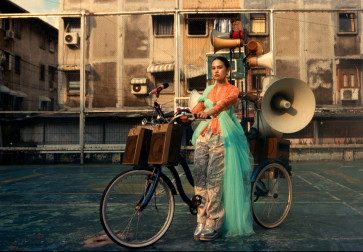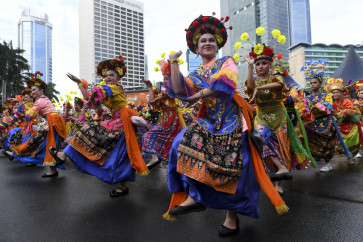Popular Reads
Top Results
Can't find what you're looking for?
View all search resultsPopular Reads
Top Results
Can't find what you're looking for?
View all search resultsContemporary Aborigine painting: industry vs identity
It took Van Gogh 10 years of privation and hardship to perfect his art; 10 years of constant practice and anguish for his brush to take a definite course and vision that eventually blazed up the fires of brilliance in The Starry Night
Change text size
Gift Premium Articles
to Anyone
I
t took Van Gogh 10 years of privation and hardship to perfect his art; 10 years of constant practice and anguish for his brush to take a definite course and vision that eventually blazed up the fires of brilliance in The Starry Night. And it took him another fifty years of waiting with the worms for the world to recognize his genius, unknown during his days. Of the more than 800 paintings he produced, only one sold during his lifetime.
But that was the late 19th century, where art galleries, even those of Paris, were still very conservative concerning the choice of paintings permitted to be displayed and offered to the public. The art authorities scorned and shunned the revolutionary artists—Van Gogh one of them—who themselves scorned and shunned established styles of paintings. Back in those days, “taste” was still a historical class-construction, a piece of bourgeois coquetry.
In “contemporary Aborigine art”, or contemporary painting in general, things are not that, strictly speaking, tough. Classless as it is society today, with the substance of power buried under the structure of profit, a sophisticated network of commercial exchange prevails, taking charge of even the autonomous sphere of art. International buyers, interstate art galleries, overseas art dealers, and intercultural art promoters are the players that make sure that painting finds its niche today, by enthroning it with a new status as business commodity, corporate furnishing and home interior accessory.
Added to that the Western’s uncompromising craze for primitive tribes, it is not surprising that “Aboriginal art”, a term which carries a great marketing substance in itself, could achieve great recognition in international art society today. After all, art becomes art through social process.
So whereas Van Gogh ended up brushing off his ear and painting a hole on his chest for the esteem of genius constantly denied him, Sally Gabori, the most popular Aboriginal painters of today, was eloquent before she could even stammer. This 86-year-old Kaiadilt began painting in 2005 and in the next few years had nestled herself on to the must-have list of international art collectors (i.e. investors), her paintings circulating various international galleries.
How are her works itself? Sally Gabori’s origin as an Aborigine would surely make one who had never seen her paintings think they embody a certain primordial nuance, a mysterious exoticism, iconographic motives and patterns, mythological undertones, totemic representations, earthy tones, or anything that would point to her unique ethnical culture and tradition of painting: no such things at all.
In reality, if one were to see Sally Gabori’s paintings without any knowledge of her indigenous background, one would innocently think, “ah, it’s another one of those abstract paintings.” And that is precisely Gabori’s appeal in the international market: her painting’s close relation and facile association to typical Western abstract art.
As Aboriginal art curator and art critic Philip Batty pointed out in his modest 2008 paper for the international art conference session Economies of Desire: Art Collecting and Dealing Across Cultures, Aborigine art has for long undergone an authenticity diminishment and cultural identity crisis through its constant exposure and exploitative connection to the Western market.
The outputs of the indigenous artists have been subtly steered over the course of the years - both consciously and unconsciously - to suit Western demands.
That is to say, what was supposed to be an authentic, intelligible indigenous tradition is forced to be comprehensible, to speak - eloquently indeed - in the jargon of Western aesthetic categories and predicates: “Abstract Expressionism”, “The sublime”, “Abstract art”, and, most ostentatiously, “Contemporary Aborigine”.
Thus, while the whole thing may in the past be deemed as a “cross-cultural” exchange, nowadays to state the term “cross-” itself would be absurd, because objectively speaking there is no more distinct line to cross: both poles have been assimilated.
Sally Gabori solo exhibition is open at The Australian High Commission, Singapore from March 4 to May 4. For further information about admission see www.redotgallery.com.










